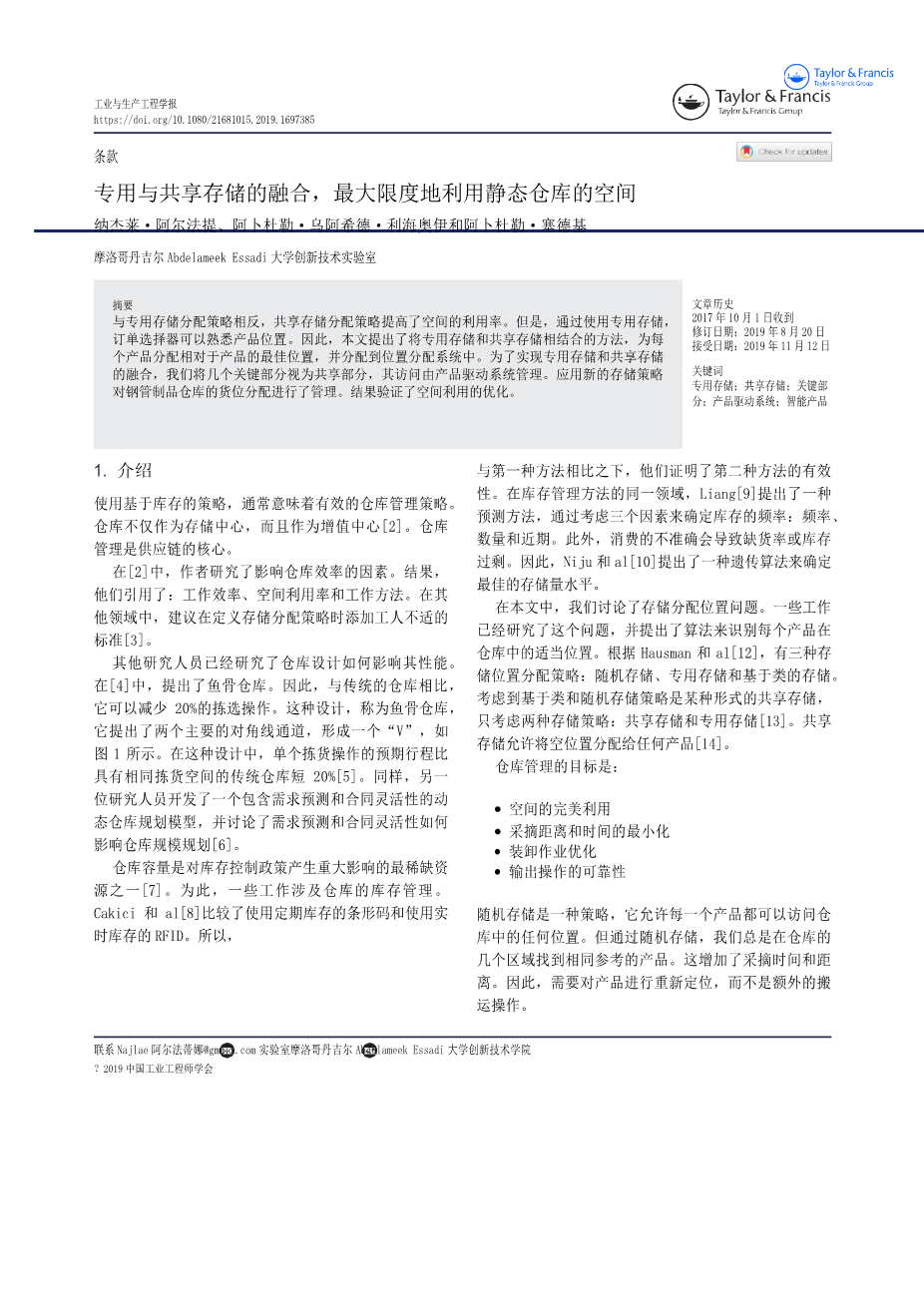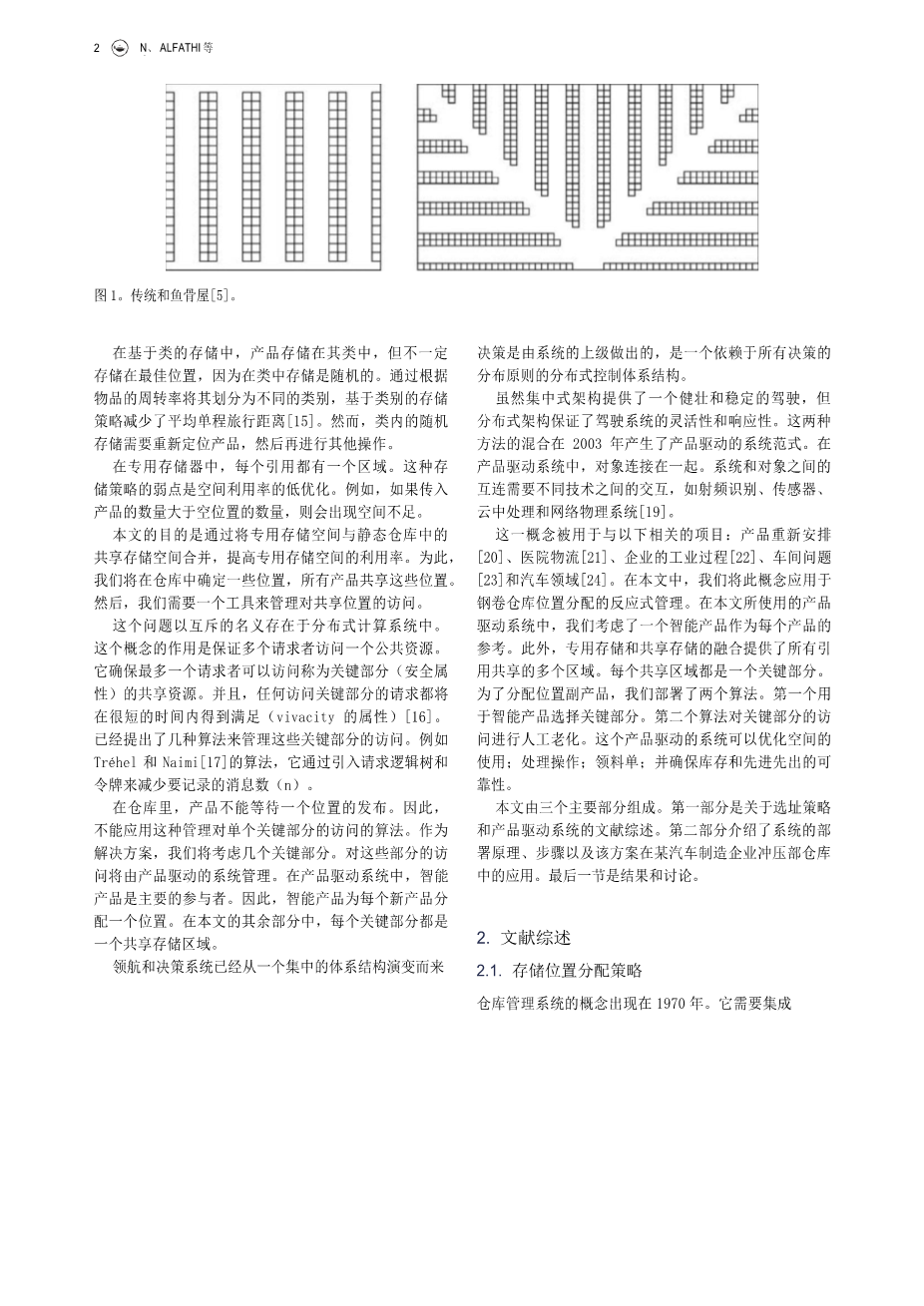Journal of Industrial and Production Engineering
ISSN: 2168-1015 (Print) 2168-1023 (Online) Journal homepage: https://www.tandfonline.com/loi/tjci21
Fusion of dedicated and shared storage to maximize the use of space of static warehouses
Najlae Alfathi, Abdelouahid Lyhyaoui amp; Abdelfettah Sedqui
To cite this article: Najlae Alfathi, Abdelouahid Lyhyaoui amp; Abdelfettah Sedqui (2019): Fusion of dedicated and shared storage to maximize the use of space of static warehouses, Journal of Industrial and Production Engineering, DOI: 10.1080/21681015.2019.1697385
To link to this article: https://doi.org/10.1080/21681015.2019.1697385
Published online: 09 Dec 2019.
Submit your article to this journal
Article views: 7
View related articles View Crossmark data
Full Terms amp; Conditions of access and use can be found at https://www.tandfonline.com/action/journalInformation?journalCode=tjci21
JOURNAL OF INDUSTRIAL AND PRODUCTION ENGINEERING
https://doi.org/10.1080/21681015.2019.1697385
ARTICLE
Fusion of dedicated and shared storage to maximize the use of space of static warehouses
Najlae Alfathi, Abdelouahid Lyhyaoui and Abdelfettah Sedqui
Laboratory of Innovative Technology, University Abdelamelek Essaadi, Tangier, Morocco
ABSTRACT
The shared storage assignment policy, contrary to the dedicated one, allows a high use of space. However, by using a dedicated storage the order pickers become familiar with product locations. Thus, we propose in this paper the fusion of dedicated and shared storage for assigning to each product the optimum location relative to the product and to the location assignment system. To make the fusion of dedicated and shared storage, we have considered several critical sections as shared sections whose access is managed by a product-driven system. The new storage policy was applied to manage the locations assignment in a steel coil warehouse. As a result, we have validated the optimization of the use of space.
ARTICLE HISTORY
Received 1 October 2017
Revised 20 August 2019
Accepted 12 November 2019
KEYWORDS
Dedicated storage; shared storage; critical section; product driven system; smart product
Introduction
The use of a strategy based on the presence of stock, implies generally an effective warehouse management strategy. Warehouses operate not only as centers for storage but also as centers for value-addition [2]. The management of warehouse is then at the center of the supply chain.
In [2], authors have studied the factors affecting the efficiency of warehouses. As results, they quoted: Work efficiency, Space utilization, and Working methods. In other work, it is proposed to add the criterion of worker discomfort in defining the storage assignment policy [3].
Other researchers have studied how a warehouse design influences its performance. In [4], the fishbone warehouse is proposed. So, it could reduce the picking operation by 20% compared to a traditional ware- house. The proposed design, called a Fishbone Warehouse, presents two main diagonal aisles that form a “V”, as seen in Figure 1. In this design, the expected travel distance of a single picking operation is up to 20% shorter than in a traditional warehouse with the same picking space [5]. In the same perspec- tive, another researcher has developed a dynamic warehouse planning model incorporating demand forecast and contract flexibility, and have addressed how demand forecast and contract flexibility affect warehouse size planning [6].
Warehouse capacity is one of the scarcest resources that greatly affect the inventory control policies [7]. For this, some works have dealt with inventory management in warehouses. Cakici and al [8] have made a comparison between the use of Barcode with a periodic inventory and the RFID with a real-time inventory. So, they justify
the effectiveness of the second compared to the first. Within the same field of inventory management meth- ods, Liang [9] has proposed a prediction method to identify the frequency of inventories by taking into account three factors: frequency, quantity, and recency. Also, the inaccuracy of the consumption can cause a stock-out-rates or over-stocking. For this reason, Niju and al [10] have presented a genetic algorithm to define an optimal level of quantity to be stored.
In this paper, we treat the storage assignment location problem. Several works have studied this problem and have presented algorithms to identify for each product the appropriate location in the warehouse. According to Hausman and al [12], there are three storage location assignment policies: Random storage, dedicated storage, and class-based storage. By considering that the class based and random storage policies are some forms of shared storage, it is considered just two storage
剩余内容已隐藏,支付完成后下载完整资料


英语译文共 21 页,剩余内容已隐藏,支付完成后下载完整资料
资料编号:[414332],资料为PDF文档或Word文档,PDF文档可免费转换为Word


